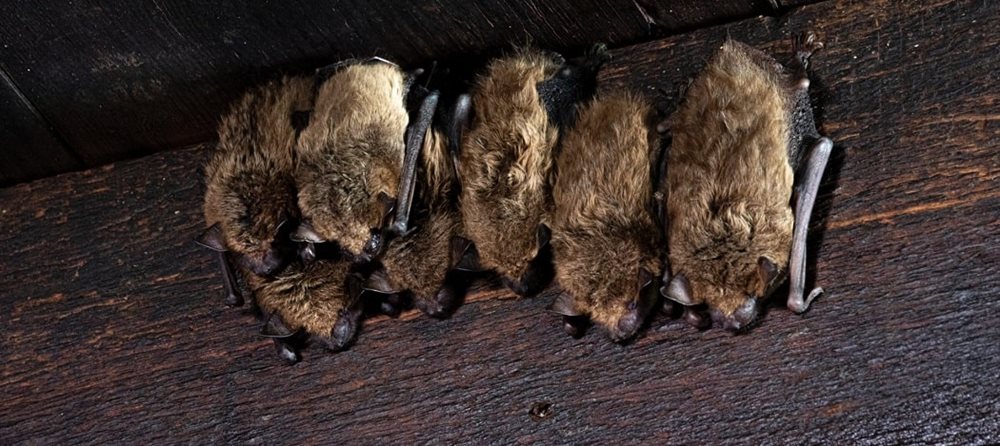
Depending on the species, bats either hibernate or migrate during the winter. The main reason is that cold weather limits the supply of insects available for bats to eat.
All bat species in the United States are insectivores. The cold weather limits the supply of insects. So during the winter, bats must migrate or hibernate. Depending on the bat’s location, winter temperatures may not drop below 35-40 degrees, which is the point at which bats may suffer from winter weather. In such cases, bats may choose to stick around the area. Others will migrate to much warmer areas where bugs are plentiful.
Bat Hibernation
During bat hibernation, it will lower its heart rate and body temperature and stay in a sleep-like state for months. Bats can drop their average heart rate of 200-300 beats per minute to 10 beats per minute. They can also go for several minutes without breathing to conserve energy.
Bats start preparing for hibernation in mid-October by eating as much as posisble. The extra fat will metabolize slowly over the winter months, sustaining them through hibernation.
Where do Bats Hibernate in Winter?
Bats thibernate in a specific areas called hibernacula, like caves, mines, cracks in mountainsides, and some trees. Bats living in urban areas may choose to hibernate locally. If so, your attic, barn, or shed is the perfect place.Some bat species hibernate alone, while others hibernate in colonies.
Bats are small and do not need large spaces to roost. They enter attics through broken screens or windows, cracked wood, or separated flashing. If your chimney cap is missing, bats may choose to live there for the winter. They also take advantage of loose siding, empty barn rafters, carports, gazebos, and other outdoor structures with access to a space protected from the outdoor elements.
Where Do Bats Migrate?
Most migratory bats in the U.S. migrate to Mexico, but there are some places within the United States that get migratory bats during the winter. Resients in the Rio Grande Valley can have bat problems from migratory bats in the winter.
Bats in Your Attic
Knowing the signs of a bat living in your home is essential. Bats tend to produce a lot of guano or feces. Bat guano may resemble rat feces, but instead of being scattered, it piles up underneath the bat’s roost. Bats often roost near the space they use to enter and exit your attic.
Another sign that bats are in your attic is hearing unfamiliar noises. Yes, bats mostly stay still during hibernation. However, some bats will temporarily come out of torpor or full hibernation when temperatures rise. When temperatures drop and become colder, bats may try to move to a warmer spot inside your home. If you hear fluttering or shuffling around, it may be a bat.
Bats use high-pitched squeaks to communicate with one another. Typically, humans cannot hear them. Occasionally, when awoken from torpor suddenly, you may be able to hear them.
Stains and smudges on your walls, floors, siding, beams, or around cracks and holes are indicators bats are present. The stains are from bat guano dripping over a bat’s body while it roosts. Bat fur is usually covered in guano.
What to Do About Bats in Your Home
Getting rid of bats from your home should involve a professional wildlife removal expert. One reason is that bats have protection federally and at the state level. With diseases like the white-nosed syndrome killing many bats, species are now threatened, and a fear of extinction exists.
We need bats and must do what we can to save them. They help balance the ecosystem by each eating thousands of insects each night. Regulations are in place to prevent the eviction of a bat during certain times of the year, like during maternity season, from May to August. During this time, removing a bat or trying to get it to leave on its own is illegal.
Bats, and their pups, must be able to survive after eviction. If you find bats hibernating in your attic during winter, it is best to wait until early autumn before trying to remove them.
Excluding Bats from Your Home
Wildlife control operators understand all laws regarding bat removal and how to prevent their return using exclusion methods. Installing one-way valves is a safe and humane way to eliminate bats. They can easily fly out of the valve, but because it narrows on the outside end, bats cannot fly back in.
Once the bats are gone, a technician will remove the valve and seal the entry point. They will also teach you how to reduce food and water sources that attract bats to your home. You don’t have to wait until you have a bat problem to get help. Call wildlife experts to learn more about prevention today.
Get them out.
Keep them out.®
Experiencing a wildlife or pest issue? We can help! Complete this form and your local Critter Control® office will contact you to assist.
- Baby Bats
- Bat Bites
- Bat Facts & Myths
- Bat Guano – Identification & Removal
- Bat Maternity Season
- Bat Noises and Sounds
- Bats & Rabies
- Watch How Bat Removal Works
- What to Do if Bats in Homes
- Bats in Chimneys
- Bats in Roofs
- Bats in the Attic
- Bats in Trees
- Bats in Walls
- Dead Bats
- Bat Diet & Feeding Schedule
- Do Bat Deterrents Work?
- How to Get Rid of Bats in Attic
- Is bat exterminating legal?
- Types of Bats
- What Does a Bat Look Like?
- Bat Habitats and Infestations
- Bat Blindness & Echolocation